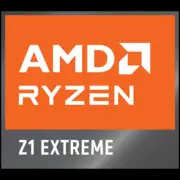AMD Ryzen Z1

AMD Ryzen Z1: Compact Power for Mobile Devices
Introduction
The AMD Ryzen Z1 is a new processor designed for mobile devices, where the key factors are balancing performance and energy efficiency. Codenamed Phoenix2 and built on a 4 nm process, it promises to be the ideal solution for ultrabooks, portable gaming systems, and hybrid devices. In this article, we will explore what the Ryzen Z1 is capable of, who it is suitable for, and how it compares to its competitors.
1. Architecture and Process: Zen 4 and RDNA 3
Cores, Threads, and Frequencies
The Ryzen Z1 is built on the Zen 4 architecture, which offers high performance per watt. The processor includes:
- 6 cores and 12 threads thanks to Simultaneous Multithreading (SMT) technology.
- Base frequency — 3.2 GHz, maximum in turbo mode — up to 4.9 GHz.
- L3 cache — 16 MB, which accelerates data processing in multitasking scenarios.
Unlike Intel's hybrid solutions (such as the 12th generation Core), all Ryzen Z1 cores are homogeneous, simplifying load management and enhancing stability in professional applications.
Integrated Graphics Radeon 740M
The graphics component is based on the RDNA 3 architecture:
- 4 compute units (CUs) with a frequency of up to 2.5 GHz.
- Support for Ray Tracing and FSR (FidelityFX Super Resolution) to improve image quality in games.
- Capability to output images in 4K@120 Hz.
This makes the Radeon 740M one of the most powerful iGPUs in its class, capable of handling light gaming and work in graphic editing software.
2. Power Consumption and TDP: Balance for Mobility
The Ryzen Z1 has a TDP of 15 W, which is typical for ultrabooks. However, AMD has provided flexible settings:
- In “Performance Tuning” mode, the TDP can temporarily increase to 30 W for short bursts (e.g., video rendering).
- Precision Boost 2 technology automatically adjusts frequencies and voltage, minimizing power consumption during idle periods.
This allows laptops with the Ryzen Z1 to operate for up to 10-12 hours with moderate usage (web browsing, office tasks).
3. Performance: Benchmarks and Real-World Tasks
Office Work and Multimedia
- Geekbench 6: Single-Core — 2180, Multi-Core — 9503. For comparison, the Intel Core i5-1335U (15 W) scores ~2000/8500, while the Apple M2 achieves ~2500/9500.
- In Microsoft Office and a browser with 20+ tabs, the processor runs without lag.
- 4K video in Premiere Pro renders in 12-15 minutes (compared to 18-20 minutes for Intel Iris Xe).
Gaming
- CS:GO on medium settings (1080p) — 80-90 FPS.
- Fortnite (720p, Low + FSR) — 50-60 FPS.
- Indie games (Hades, Stardew Valley) — stable 60 FPS.
Turbo mode activates within 5-10 seconds under load, but in compact devices, it may be limited by the cooling system. For example, in the mini-PC Asus ROG Ally, the frequency is held at 4.5 GHz for 3-4 minutes.
4. Use Cases: Who is the Ryzen Z1 For?
- Students and office workers — for working with documents, Zoom conferences, and light video editing.
- Travelers — thanks to battery life and support for fast charging.
- Casual gamers — games like Apex Legends or Genshin Impact on minimum settings.
- Freelance designers — photo editing in Lightroom, drawing in Photoshop.
5. Battery Life: How Long Will the Battery Last?
With a TDP of 15 W and a battery capacity of 60 Wh:
- Video playback (YouTube, 1080p) — up to 10 hours.
- Working in Word/Excel — 8-9 hours.
- Gaming — 2-3 hours.
Power-saving technologies:
- AMD PowerNow! — dynamic switching between performance modes.
- Adaptive Power Management — reducing core voltage during idle periods.
6. Comparison with Competitors
- Intel Core i5-1335U (10 cores, 12 threads): Better for single-threaded tasks but weaker in graphics (Iris Xe vs. Radeon 740M).
- Apple M2: Higher performance in applications optimized for macOS, but limited gaming support.
- AMD Ryzen 5 6600U (Zen 3+): The Ryzen Z1 is 15-20% faster thanks to Zen 4 and improved iGPU.
7. Pros and Cons
Strengths
- High multi-threaded performance.
- Powerful integrated graphics.
- Energy efficiency.
- Support for modern technologies (PCIe 4.0, Wi-Fi 6E).
Weaknesses
- Throttling may occur in compact cases under sustained loads.
- Not suitable for AAA gaming on high settings.
8. Laptop Selection Recommendations
- Type of device: Ultrabooks (e.g., Asus Zenbook), 2-in-1 hybrids (Lenovo Yoga), portable gaming systems (Asus ROG Ally).
- What to pay attention to:
- Cooling system — at least two fans for stable turbo operation.
- Display — IPS matrix with sRGB coverage for color correction.
- Battery — at least 50 Wh for 6+ hours of autonomy.
9. Final Conclusion
The AMD Ryzen Z1 is a processor for those seeking mobility without compromise. It is ideal for:
- Everyday tasks (office, study, travel).
- Light gaming and creative projects.
- Devices with long battery life.
Its key advantages are energy efficiency, powerful graphics, and support for modern standards. If you don’t need a top-tier GPU or 8K video rendering, the Ryzen Z1 is an excellent choice for a reasonable price.
Basic
CPU Specifications
Memory Specifications
GPU Specifications
Benchmarks
Compared to Other CPU
Share in social media
Or Link To Us
<a href="https://cputronic.com/cpu/amd-ryzen-z1" target="_blank">AMD Ryzen Z1</a>